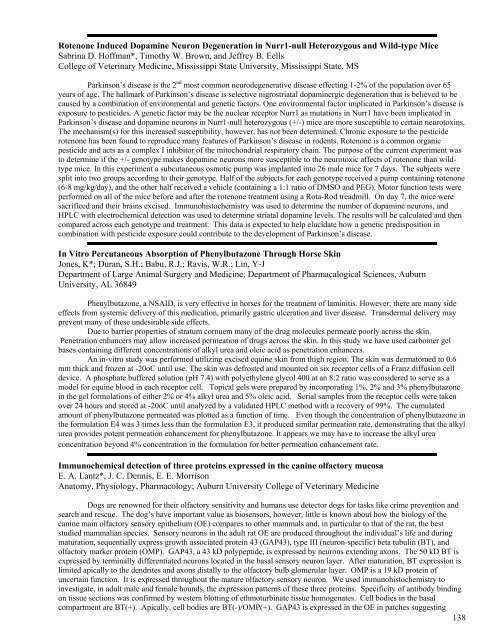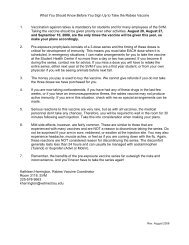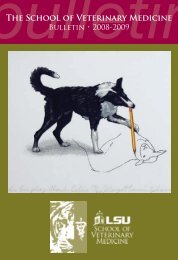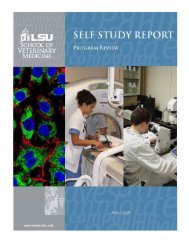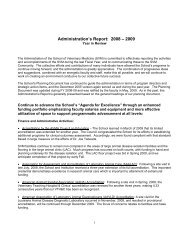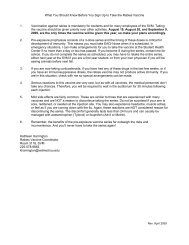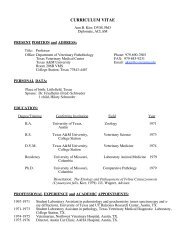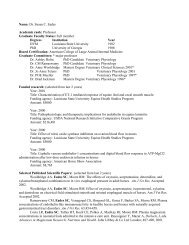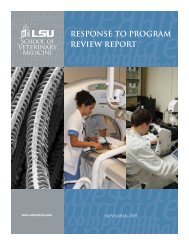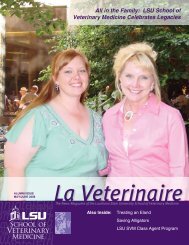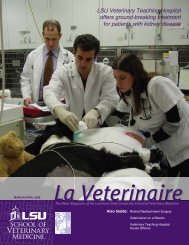Rotenone Induced Dopamine Neuron Degeneration in Nurr1-null Heterozygous and Wild-type MiceSabrina D. H<strong>of</strong>fman*, Timothy W. Brown, and Jeffrey B. EellsCollege <strong>of</strong> <strong>Veterinary</strong> <strong>Medicine</strong>, Mississippi <strong>State</strong> University, Mississippi <strong>State</strong>, MSParkinson’s disease is the 2 nd most common neurodegenerative disease effecting 1-2% <strong>of</strong> the population over 65years <strong>of</strong> age. The hallmark <strong>of</strong> Parkinson’s disease is selective nigrostriatal dopaminergic degeneration that is believed to becaused by a combination <strong>of</strong> environmental and genetic factors. One environmental factor implicated in Parkinson’s disease isexposure to pesticides. A genetic factor may be the nuclear receptor Nurr1 as mutations in Nurr1 have been implicated inParkinson’s disease and dopamine neurons in Nurr1-null heterozygous (+/-) mice are more susceptible to certain neurotoxins.The mechanism(s) for this increased susceptibility, however, has not been determined. Chronic exposure to the pesticiderotenone has been found to reproduce many features <strong>of</strong> Parkinson’s disease in rodents. Rotenone is a common organicpesticide and acts as a complex I inhibitor <strong>of</strong> the mitochondrial respiratory chain. The purpose <strong>of</strong> the current experiment wasto determine if the +/- genotype makes dopamine neurons more susceptible to the neurotoxic affects <strong>of</strong> rotenone than wildtypemice. In this experiment a subcutaneous osmotic pump was implanted into 26 male mice for 7 days. The subjects weresplit into two groups according to their genotype. Half <strong>of</strong> the subjects for each genotype received a pump containing rotenone(6-8 mg/kg/day), and the other half received a vehicle (containing a 1:1 ratio <strong>of</strong> DMSO and PEG). Motor function tests wereperformed on all <strong>of</strong> the mice before and after the rotenone treatment using a Rota-Rod treadmill. On day 7, the mice weresacrificed and their brains excised. Immunohistochemistry was used to determine the number <strong>of</strong> dopamine neurons, andHPLC with electrochemical detection was used to determine striatal dopamine levels. The results will be calculated and thencompared across each genotype and treatment. This data is expected to help elucidate how a genetic predisposition incombination with pesticide exposure could contribute to the development <strong>of</strong> Parkinson’s disease.In Vitro Percutaneous Absorption <strong>of</strong> Phenylbutazone Through Horse SkinJones, K*; Duran, S.H.; Babu, R.J.; Ravis, W.R.; Lin, Y-JDepartment <strong>of</strong> Large Animal Surgery and <strong>Medicine</strong>; Department <strong>of</strong> Pharmacalogical Sciences, AuburnUniversity, AL 36849Phenylbutazone, a NSAID, is very effective in horses for the treatment <strong>of</strong> laminitis. However, there are many sideeffects from systemic delivery <strong>of</strong> this medication, primarily gastric ulceration and liver disease. Transdermal delivery mayprevent many <strong>of</strong> these undesirable side effects.Due to barrier properties <strong>of</strong> stratum cornuem many <strong>of</strong> the drug molecules permeate poorly across the skin.Penetration enhancers may allow increased permeation <strong>of</strong> drugs across the skin. In this study we have used carbomer gelbases containing different concentrations <strong>of</strong> alkyl urea and oleic acid as penetration enhancers.An in-vitro study was performed utilizing excised equine skin from thigh region. The skin was dermatomed to 0.6mm thick and frozen at -20oC until use. The skin was defrosted and mounted on six receptor cells <strong>of</strong> a Franz diffusion celldevice. A phosphate buffered solution (pH 7.4) with polyethylene glycol 400 at an 8:2 ratio was considered to serve as amodel for equine blood in each receptor cell. Topical gels were prepared by incorporating 1%, 2% and 3% phenylbutazonein the gel formulations <strong>of</strong> either 2% or 4% alkyl urea and 5% oleic acid. Serial samples from the receptor cells were takenover 24 hours and stored at -20oC until analyzed by a validated HPLC method with a recovery <strong>of</strong> 99%. The cumulatedamount <strong>of</strong> phenylbutazone permeated was plotted as a function <strong>of</strong> time. Even though the concentration <strong>of</strong> phenylbutazone inthe formulation E4 was 3 times less than the formulation E3, it produced similar permeation rate, demonstrating that the alkylurea provides potent permeation enhancement for phenylbutazone. It appears we may have to increase the alkyl ureaconcentration beyond 4% concentration in the formulation for better permeation enhancement rate.Immunochemical detection <strong>of</strong> three proteins expressed in the canine olfactory mucosaE. A. Lantz*, J. C. Dennis, E. E. MorrisonAnatomy, Physiology, Pharmacology; Auburn University College <strong>of</strong> <strong>Veterinary</strong> <strong>Medicine</strong>Dogs are renowned for their olfactory sensitivity and humans use detector dogs for tasks like crime prevention andsearch and rescue. The dog’s have important value as biosensors, however, little is known about how the biology <strong>of</strong> thecanine main olfactory sensory epithelium (OE) compares to other mammals and, in particular to that <strong>of</strong> the rat, the beststudied mammalian species. Sensory neurons in the adult rat OE are produced throughout the individual’s life and duringmaturation, sequentially express growth associated protein 43 (GAP43), type III (neuron-specific) beta tubulin (BT), andolfactory marker protein (OMP). GAP43, a 43 kD polypeptide, is expressed by neurons extending axons. The 50 kD BT isexpressed by terminally differentiated neurons located in the basal sensory neuron layer. After maturation, BT expression islimited apically to the dendrites and axons distally to the olfactory bulb glomerular layer. OMP is a 19 kD protein <strong>of</strong>uncertain function. It is expressed throughout the mature olfactory sensory neuron. We used immunohistochemistry toinvestigate, in adult male and female hounds, the expression patterns <strong>of</strong> these three proteins. Specificity <strong>of</strong> antibody bindingon tissue sections was confirmed by western blotting <strong>of</strong> ethmoturbinate tissue homogenates. Cell bodies in the basalcompartment are BT(+). Apically, cell bodies are BT(-)/OMP(+). GAP43 is expressed in the OE in patches suggesting138
nodes <strong>of</strong> mitotic activity. All three proteins are expressed in the axons <strong>of</strong> the olfactory nerve. Immunoblots probed with anti-OMP/BT antisera show single bands in the approximately appropriate locations. Anti-GAP43 antisera shows a light bandbetween the 85 and 41.7 kD markers and a heavy band at 128 kD. All three proteins migrated above their respectivemolecular weights relative to the MW markers. These observations confirm that the canine OE expresses these three proteinsand that they are expressed in anatomical and developmental patterns very similar to those observed in rat OE.Dietary and Hormonal Regulation <strong>of</strong> SHIP-2 ExpressionBrooke Lechlitner* and Nagendra Prasad<strong>School</strong> <strong>of</strong> <strong>Veterinary</strong> <strong>Medicine</strong>, Basic Medical Sciences, Purdue UniversityObesity is becoming a major epidemic in Western society and leading to major illnesses, such as non-insulindependent (Type II) diabetes, cardiovascular disease, and cancers <strong>of</strong> the endometrium, colon, and breast. SHIP-2, SH2-containing inositol phosphatase 2, is a down-stream regulator <strong>of</strong> insulin-signaling. SHIP-2 also appears to regulate signalingpathways other than insulin, which has potential implications in relation to cardiovascular disease and cancer. However, theregulation <strong>of</strong> SHIP-2 expression remains largely unknown. SHIP-2 genetic knock-out in mice prevents obesity when the miceare fed a high-fat diet and SHIP-2 is up-regulated in the muscle and adipose tissue <strong>of</strong> obese mice by unknown mechanisms.,Therefore, the objective <strong>of</strong> this study was to determine whether SHIP-2 expression is regulated by hormones <strong>of</strong> metabolicimportance or dietary components associated with obesity and diabetes. MCF-7 breast cancer cell line model was employedto study the effects <strong>of</strong> leptin, insulin, glucose, amino acids, and combinations there<strong>of</strong>, on SHIP-2 protein levels using WesternBlot analysis. Preliminary observations indicate a possible effect by glucose, leptin, insulin, and their combinations, on SHIP-2 induction. Further studies will be required to establish a clear connection between SHIP-2, diet, and the obesity-relatedillnesses.Meloxicam use in avian rehabilitation: evaluation <strong>of</strong> dosage and dosing frequency as compared to aspirin(acetylsalicylic acid)Sharon E Parker*, University <strong>of</strong> Pennsylvania <strong>School</strong> <strong>of</strong> <strong>Veterinary</strong> <strong>Medicine</strong>Erica Miller, DVM, Tri-<strong>State</strong> Bird Rescue and Research, Inc.Lisa Murphy, VMD, University <strong>of</strong> Pennsylvania <strong>School</strong> <strong>of</strong> <strong>Veterinary</strong> <strong>Medicine</strong>, New Bolton Center - ToxicologyLab; Tri-<strong>State</strong> Bird Rescue and Research, Inc.; University <strong>of</strong> Pennsylvania <strong>School</strong> <strong>of</strong> <strong>Veterinary</strong> <strong>Medicine</strong>, NewBolton Center - Toxicology LabEffective pain management is crucial to the successful rehabilitation <strong>of</strong> all species. In domestic animals, thisfrequently includes the use <strong>of</strong> non-steroidal anti-inflammatory drugs (NSAIDs); however, for wildlife and avian species inparticular, there is very little research defining their proper use. This study is focusing on the NSAID meloxicam, hoping todefine its half-life in two species <strong>of</strong> native wild birds commonly seen in rehabilitation practices: Canada geese (Brantacanadensis) and Red-tailed hawks (Buteo jamaicensis). Both <strong>of</strong> these species are covered under a current research permit forTri-<strong>State</strong> Bird Rescue and Research, Inc., where the work is being preformed. Over the course <strong>of</strong> the study, meloxicam willbe compared with the equivalent dose <strong>of</strong> aspirin (acetylsalicylic acid). Half-lives will be elucidated for both drugs, andcurrent dosing and dosage frequencies will be evaluated for efficacy based on drug concentrations in blood plasma andcorrelations with clinical observations. Each treatment group (including species, drug, and time after administration) willhave a minimum <strong>of</strong> six individual birds, so as to be statistically significant. It is expected that meloxicam will be a moreeffective and less frequently dosed drug than aspirin, lending itself to a more practical use in wildlife rehabilitation.Pharmacokinetic and Pharmacodynamic Modeling <strong>of</strong> Oral Dexamethasone Administered to Healthy HorsesAmanda Sherck, BS*; Elizabeth Davis, DVM, PhD, DACVIM; Jason Grady, DVM; Butch KuKanich, DVM,PhD, DACVCPCollege <strong>of</strong> <strong>Veterinary</strong> <strong>Medicine</strong>, Kansas <strong>State</strong> UniversityDexamethasone is a corticosteroid commonly administered in equine medicine for the management <strong>of</strong> inflammatoryand immune-mediated conditions. Oral administration <strong>of</strong> corticosteroids to horses is hampered by economic practicality andintermittent availability <strong>of</strong> commercial preparations. Typical treatment protocols administer tapering dosages over time, withlower dosages administered orally. The purpose <strong>of</strong> this study was to evaluate different formulations <strong>of</strong> dexamethasoneadministered orally in horses. Six healthy horses were randomly assigned to each <strong>of</strong> six treatment groups, such that each horsereceived dexamethasone intravenously, orally (injectable solution), and orally (compounded powder), under both fed and fastedconditions. Plasma and serum samples were collected immediately prior to treatment and at predetermined intervals to 72hours.Plasma was analyzed for dexamethasone by LC/MS, and serum cortisol levels were measured by achemiluminescent enzyme immunoassay. Preliminary data suggest that intravenous administration <strong>of</strong> dexamethasone yieldsthe highest plasma drug concentrations, whereas oral administration results in lower drug concentrations and incompletebioavailability. However, cortisol is suppressed for each treatment and is suppressed longer by oral administration <strong>of</strong>dexamethasone than intravenous dexamethasone. Increases in plasma dexamethasone appear to correspond to a delayed139
- Page 1 and 2:
2006 MERCK/MERIALNATIONAL VETERINAR
- Page 6 and 7:
3:00-3:30 pm BreakNovel therapy for
- Page 8 and 9:
KEYNOTE SPEAKERRonald Veazey, D.V.M
- Page 10 and 11:
Mini Symposium II:Fish Research: A
- Page 12 and 13:
David G. Baker, D.V.M., M.S., Ph.D.
- Page 14 and 15:
Konstantin G. Kousoulas, Ph.D.Profe
- Page 16 and 17:
Joseph Francis, B.V.Sc., M.V.Sc., P
- Page 18 and 19:
dogs with cancer, the potential rol
- Page 20 and 21:
2006 MERCK/MERIALVETERINARY SCHOLAR
- Page 22 and 23:
YOUNG INVESTIGATOR AWARD HONORABLE
- Page 24 and 25:
Mammary epithelial-specific deletio
- Page 26 and 27:
2006 MERCK/MERIALVETERINARY SCHOLAR
- Page 28:
Variation in Q-Tract Length of the
- Page 34:
Novel therapy for humoral hypercalc
- Page 38:
ALTERNATE:Micron-scale membrane sub
- Page 42 and 43:
ABSTRACT TITLES LISTED BY CATEGORY
- Page 44 and 45:
19. A pilot study of cigarette smok
- Page 46 and 47:
36. Development of a murine in vitr
- Page 48 and 49:
ABSTRACT TITLES LISTED BY CATEGORY
- Page 50 and 51:
71. Identification and characteriza
- Page 52 and 53:
85. Age and Gender Influence Ventil
- Page 54 and 55:
ABSTRACT TITLES LISTED BY CATEGORY
- Page 56 and 57:
2006 MERCK/MERIALVETERINARY SCHOLAR
- Page 58 and 59:
10. Preliminary estimation of risk
- Page 60 and 61:
ABSTRACT TITLES LISTED BY CATEGORY
- Page 62 and 63:
47. Osteoprotegerin and Receptor Ac
- Page 64 and 65:
61. A Comparison of Interaction Pat
- Page 66 and 67:
ABSTRACT TITLES LISTED BY CATEGORY
- Page 68 and 69:
ABSTRACT TITLES LISTED BY CATEGORY
- Page 70 and 71:
ABSTRACT TITLES LISTED BY CATEGORY
- Page 72 and 73:
2006 MERCK/MERIALVETERINARY SCHOLAR
- Page 74 and 75:
used to label avian heterophils for
- Page 76 and 77:
obtained via analysis of time and d
- Page 78 and 79:
0.71mg/dL; p=0.001). Values for hem
- Page 80 and 81:
mass and fecundity in prespawning w
- Page 82 and 83:
Equine Hoof Laminae Tissue Collecti
- Page 84 and 85:
Aspiration Pneumonia in DogsDavid A
- Page 86 and 87:
Distortion Product Otoacoustic Emis
- Page 88 and 89: tyrosine phosphorylation is measure
- Page 90 and 91: the gravid and non-gravid females t
- Page 92 and 93: egulatory function as its ortholog,
- Page 94 and 95: PATHOLOGY, TOXICOLOGY, AND ONCOLOGY
- Page 96 and 97: Markers of Oxidative Stress in plas
- Page 98 and 99: has been isolated from all samples
- Page 100 and 101: Matrix metalloproteinase secretion
- Page 102 and 103: Reproductive performance, neonatal
- Page 104 and 105: control to determine the efficiency
- Page 106 and 107: Enhancing the Quality and Reliabili
- Page 108 and 109: grade II MCTs into groups with good
- Page 110 and 111: Transcriptional Regulation of the I
- Page 112 and 113: MICROBIOLOGY AND IMMUNOLOGY (SESSIO
- Page 114 and 115: colonization of the mutant and 6 re
- Page 116 and 117: digestive tracts of these and other
- Page 118 and 119: 100 pfu BRSV. The results show that
- Page 120 and 121: Inhibition of Microneme Secretion i
- Page 122 and 123: Adherent bacilli were present in th
- Page 124 and 125: isolated to analyze cytokine gene e
- Page 126 and 127: purified, viral RNA was extracted a
- Page 128 and 129: The effects of co-engagement of TLR
- Page 130 and 131: Occurrence of Leptospira Vaccine Fa
- Page 132 and 133: undifferentiated catecholaminergic
- Page 134 and 135: the concept that the greater detoxi
- Page 136 and 137: quantitative PCR using gene targets
- Page 140 and 141: decrease in serum cortisol, with a
- Page 142 and 143: and detrimental impacts on the brai
- Page 144 and 145: actions of cells prior to embryo de
- Page 146 and 147: Utilizing cDNA Subtraction to Exami
- Page 148 and 149: expression in unilaterally pregnant
- Page 150 and 151: Salmonella is increased. Poultry sa
- Page 152 and 153: exports. The estimated prevalence o
- Page 154 and 155: eeding grounds near Minnedosa, MB s
- Page 156 and 157: (PBMC) were isolated using commerci
- Page 158 and 159: 2006 MERCK/MERIALVETERINARY SCHOLAR
- Page 160 and 161: Trainees acquire in-depth knowledge
- Page 162 and 163: comparative pathology and/or resear
- Page 164 and 165: Department of Veterinary Bioscience
- Page 166 and 167: PhD, Director, Center for Comparati
- Page 168 and 169: 2006 MERCK/MERIALVETERINARY SCHOLAR
- Page 170 and 171: MICHIGAN STATEUNIVERSITYJames Crawf
- Page 172: UNIVERSITY OFPENNSYLVANIALindsay Th


